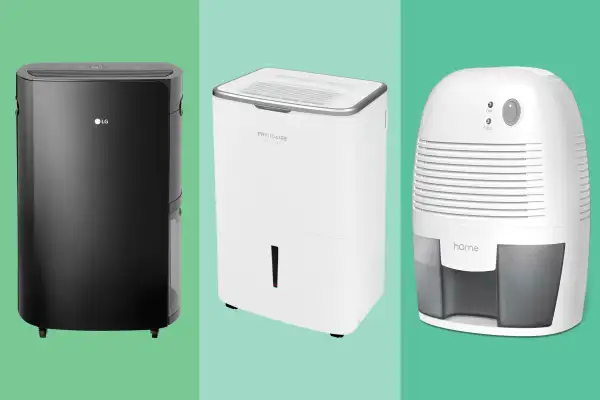The Best Dehumidifiers for Your Money

Humidity is not just annoying and uncomfortable. It can also be very damaging. Humid air is more prone to transport odors and bacteria, resulting in bigger risk of mold and mildew — and illnesses for people living there. This is why dehumidifiers are so important: They help prevent allergies and respiratory disease, and protect your home and belongings from mold.
There are a few different kinds of dehumidifiers, but they all pull in humid air, condense the water in it, and remove that moisture from the air. Thermoelectric dehumidifiers work for small, not-so-humid areas by using what’s known as the Peltier module, a piece of metal that by means of electricity is cold on one side and warm on the other. A small fan pulls the air in, and the cold side condenses the moisture.
However, the most effective dehumidifiers use a compressor, which actively cools the coils inside with refrigerant, much like a refrigerator. These coils can reach lower temperatures than a thermoelectric dehumidifier, and more humidity is trapped. Compressor dehumidifiers are the more expensive option, but they also tend to use larger, more powerful fans and simply do an altogether better job.
There are also very simple and inexpensive products for removing moisture. For around $10 or less, many stores sell boxes that come with a filter and moisture absorbent pellets, but they're only useful in very small, contained places, like inside a cupboard, under the sink, or in very small bathrooms.
All but one of our best dehumidifier selections use compressors since they provide the best performance possible.
Dehumidifier buying guide
Before buying a dehumidifier, you need to measure the room you want to place it in, and gauge how humid it is using a hygrometer. After all, it would be pointless to buy a small pellet-based dehumidifier for a 1,000-square-foot basement in the middle of the tropics.
Here are some specifications to factor in when deciding what dehumidifier to buy:
• Pints per day. The Department of Energy and Energy Star grades the performance of a dehumidifier by measuring how many pints of moisture it can remove daily. To figure out what capacity you need, you should factor how big the room is where you're using the dehumidifier and how humid the air is. For a 300- to 500-square-foot room with 50% humidity, the normally recommended capacity is 20 pints. If either the humidity level or the square footage is higher, the capacity of the dehumidifier should increase in order to do its job well. At the moment, the highest-rated dehumidifier (excluding commercial-grade models) is a 60-pint model by Frigidaire. You may see some 70-pint rated models at stores, but that’s because they’re based on an older rating system. As confusing as it may seem, 70-pint rated dehumidifiers are now rated at 50-pints, including our top pick.
• CFM (Cubic Feet per Minute). CFM measures the amount of air a fan can move, and this helps determine how large an area the dehumidifier can handle. The higher the pints-per-day rating, the more humidity it traps; the higher the CFM, the bigger the area it can cover at a faster rate (as long as the capacity can handle it).
• Bucket size. The dehumidifier's bucket is usually where all the water removed from the air is kept, and its size is indicated as ounces, gallons, or pints. A larger bucket means you’ll have to empty it out fewer times during the day or week. Aside from the bucket’s size, you should consider how easy it can be removed from the unit, and whether there’s a risk of spilling. Some models have buckets that are open at the top, but the best have splash guards to keep that from happening.
• Hose and pump. Most dehumidifiers have a drainage port where you can connect a hose and drain the moisture into a sink, bathtub or yard. That way, you don’t have to constantly be emptying out the bucket. (Sometimes an adapter is needed, but for the most part, dehumidifiers are designed to be used with a regular garden hose.) Before buying a dehumidifier, think about where you’re placing it and if it's possible to drain the water instead of filling up a bucket. Also, take note of where the hose attachment is located — it may be accessible from the back, or hidden away behind the bucket — to make sure that it will suit your needs. Some models, like the LG PuriCare, have a pump to help push the water out, but many dehumidifiers do not have this feature and instead must rely on gravity.
To choose the best dehumidifiers, we looked for those that met industry standards. Energy Star rates dehumidifiers that collect 20 pints per day or more, so — with the exception of the mini dehumidifier — our picks stay above that line. We also took into account brand reliability, warranties, and consumer reviews. Then we analyzed the specs mentioned above: power, speed, and additional features. Here’s what we recommend.
Best dehumidifiers
Best overall: LazyDry Dehumidifier
Pints Per Day: 100 │CFM: Doesn’t apply │ Bucket Size: 1.3 gallons
The Lazy Pro 100-Pint Large Dehumidifier is the ultimate solution to maintaining a comfortable and moisture-free environment. Say goodbye to dampness, mold, and musty odors with this powerhouse of dehumidification technology. Designed to tackle even the most challenging spaces, this dehumidifier can efficiently remove up to 100 pints of excess moisture per day. It is sure to transform your living spaces for freshness and comfort.
Unleash the Lazy Pro's prowess in areas where humidity reigns supreme. From basements and crawl spaces to larger living areas, this dehumidifier is suitable for various locations. Equipped with cutting-edge technology, this dehumidifier silently prevents mold growth and safeguards your belongings from the damaging effects of excess moisture. The user-friendly control panel allows you to customize settings effortlessly. You can tailor the dehumidification process to your specific needs. It takes the lead in efficient humidity control, making it the top choice on our list.
Best moisture control: Pro Breeze Dehumidifier
Experience the ultimate moisture control with the Pro Breeze Dehumidifier, which is a compact and efficient solution to transform your living space. Designed for small rooms and areas, this lightweight dehumidifier is a powerhouse, capable of extracting up to 9 ounces of water per day with a 16-ounce water tank capacity. Perfectly suited for spaces of about 225 square feet, it's an ideal bathroom dehumidifier that brings comfort and freshness to your environment.
Safety is paramount, and the Pro Breeze Dehumidifier ensures worry-free operation. Equipped with an auto shut-off feature, this bedroom dehumidifier intelligently halts its operation and activates an LED indicator when the water tank is full, signaling the need for draining.
Delight in serene surroundings as this dehumidifier performs its magic with remarkable quietness. Experience the whisper-quiet operation in bedrooms, bathrooms, and offices. Remarkably efficient, it consumes a mere 23W per hour, translating to a daily cost of just $0.07, and your best solution for tackling humidity without breaking the bank.
Best design: Frigidaire High Efficiency 50-Pint Dehumidifier With Wi-Fi
Pints Per Day: 50 │CFM: 167-229 │ Bucket Size: 16.9 pints
Frigidaire makes the most powerful residential dehumidifiers. The brand's 50-pint model, at 229 maximum CFM, has the most powerful fan and the largest bucket among its 50-pint competitors. It also boasts Wi-Fi connectivity, so you can control it through the proprietary Frigidaire app, or through Alexa or Google Home. Lastly, there’s an ionizer included so it helps reduce bacteria and other allergens.
These features come at a cost, though, and the Frigidaire is around $150 more expensive than its hOmeLabs counterpart. So if you don’t need the Wi-Fi and your designated area doesn't need that much power, check that one out too.
Editor's pick: hOmeLabs 1,500 Sq. Ft. Energy Star 22-Pint Dehumidifier
Pints Per Day: 22 │CFM: 129-138 │ Bucket Size: 8 pints
As its name suggests, hOmeLabs (yes, that's how they write the brand name, with a lowercase "h" and capitalized "O" and "L") makes a lot of gadgets and appliances, but the brand really shines with its dehumidifiers. They make models from 22 pints per day up to 50, but it’s their 22-pint model that competes strongly in its size class. Normally listed at $169.99, it’s tied for the highest CFM in the category and double the warranty (two years versus the usual one). It also has a continuous mode, an easy-to-reach hose attachment, and its thin, square shape makes it easy to position around the house.
It does, however, have a small bucket, with only 8 pints of capacity. If it were placed in a spot where it was to catch as much moisture as possible, that would mean three bucket changes a day. There is no splash guard, either, so dumping water from the bucket could be especially annoying. It also lacks a low-energy mode, so if you find yourself wanting less noise or save an unknown amount of pennies, you won’t be able to go below 129 CFM.
Best mini dehumidifier: hOmeLabs Small Space 16oz Dehumidifier
Pints Per Day: 0.6 │CFM: Doesn’t apply │ Bucket Size: 1 pint
Tiny dehumidifiers are all very similar — they all use the thermoelectric effect (as opposed to compressors in larger models) and sport similar designs. The differences show in the fan that’s used or the quality of build. We chose the hOmeLabs model due to the company’s track record with dehumidifiers and its solid warranty. It’s rated for half a pint a day, and according to hOmeLabs' website, it can cover 150 cubic feet.
Keep in mind that this small, low-price dehumidifier is not intended for large spaces or high-humidity environments. It's meant for very small spaces like closets, cupboards or very small bathrooms, in regions where humidity is not that big of an issue.
Best smart dehumidifier: LG PuriCare 50-Pint Dehumidifier w/ Wi-Fi and Pump
Pints Per Day: 50 │CFM: 158-194 │ Bucket Size: 13.3 pints
LG designs some of the best-looking appliances out there, and its dehumidifiers are no exception. They only have one capacity available, though: 50 pints. LG has two variants of the same model: one is simple, with no Wi-Fi connectivity or automated pump, and then there’s our pick. The PuriCare connects to LG’s ThinQ app, which connects all of your LG appliances. You can monitor humidity and bucket capacity, and control every setting through your phone or compatible smart assistants. Its most valuable asset is the seamless integration into your smart ecosystem.
It also has an automated pump to drain continuously into a direct drain pipe. This helps avoid clogging or leaking, which could happen with a regular hose that’s just aided by gravity. And you’ll want to drain the water automatically because, at 13.3 pints, the LG’s bucket is one of the smallest. It’s worth mentioning, however, that the bucket removal process is easier than others.
More From Money:
The Best Smart Thermostats for Your Money, According to Heating and Energy Experts
The Best Gutter Guards for Your Money, According to Roofers and Home Improvement Pros
